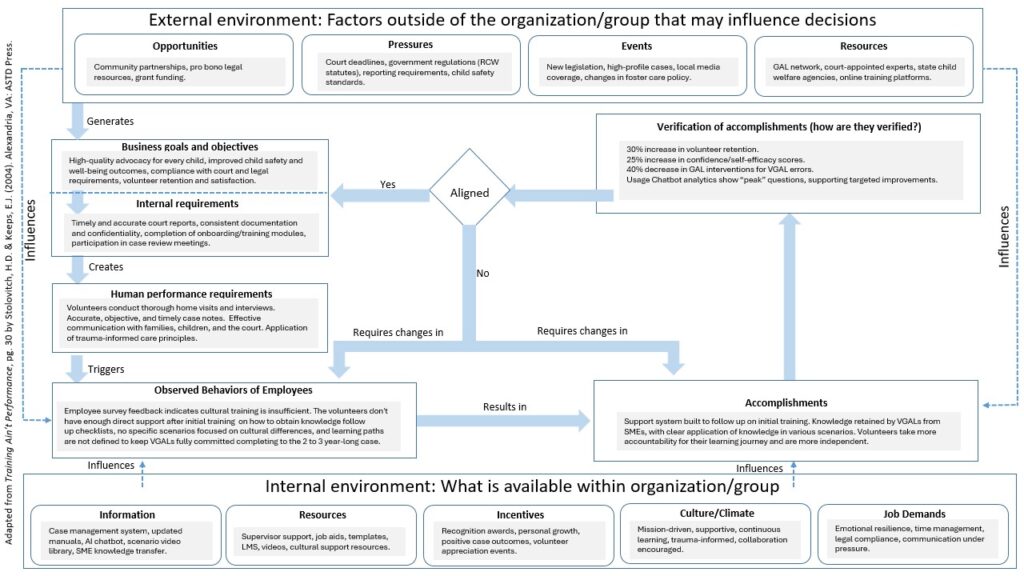As an instructional designer focused on real-world impact, I’ve recently led the design of a change management plan for Safe Kids Advocates—a non-profit dedicated to empowering volunteer guardians ad litem (VGALs) to advocate for children’s best interests. I want to share both the plan and the lessons I’m learning in the process, because successful change isn’t just about new tools or policies—it’s about supporting people as they grow, adapt, and thrive.
The Challenge: Bridging the Gap from Training to Practice
When I started this project, our biggest challenge was clear: New VGAL volunteers completed a rigorous onboarding program, but still left feeling uncertain about their roles. Many asked, “What do I do now?” Others felt overwhelmed by dense procedural manuals, unsure how to turn training into action. The result? High early attrition, inconsistent documentation, and missed opportunities to make a difference.
Building a Vision for Change
Our vision was simple but ambitious: Move beyond a “one-and-done” training event, and build a launch-pad experience that turns new volunteers into confident, independent advocates. I wanted every volunteer to feel supported at every stage—from swearing in, to the first home visit, to courtroom advocacy and beyond.
Designing a Supportive Ecosystem
The heart of my change management plan is a holistic, people-centered support system. Here’s how we’re making it happen:
- Just-in-Time AI Coaching: We’re rolling out a mobile and web-based AI micro-coach that gives volunteers instant answers, checklists, and sample language right when they need it—helping them act with confidence in the field.
- Buddy System: Every new VGAL is paired with an experienced mentor for hands-on support, collaborative job aid creation, and real-time feedback. This flattens hierarchies and turns onboarding into a team sport.
- Scenario-Based Microlearning: Instead of lectures, volunteers practice real-world cases in safe, supportive environments—especially around cultural competence and difficult conversations.
- Recognition & Motivation: We’re launching a digital badge and recognition program that rewards learning, effort, and creativity—not just “success.” Volunteers are celebrated for growth, not just perfection.
- Continuous Feedback: Pulse surveys, feedback loops, and peer sharing channels keep the system alive and evolving, so we can spot issues early and adapt quickly.
Change Management in Action: The Kotter Model
To anchor these changes, I leaned heavily on Kotter’s 8-Step Change Model:
- Create Urgency: I started by sharing honest data about attrition and performance gaps, and real stories from volunteers. This built early buy-in and made the case for change undeniable.
- Build a Guiding Coalition: We formed a diverse leadership team—mixing staff, experienced volunteers, and early adopters—to model new behaviors and drive the change from within.
- Develop a Shared Vision: Through co-creation workshops, we crafted a clear vision and mapped out how all the interventions would interlock.
- Communicate, Communicate, Communicate: We used meetings, newsletters, and even visual dashboards to reinforce the vision, celebrate wins, and keep everyone engaged.
- Empower Broad Action: By removing barriers (like tech access or outdated SOPs), and encouraging ideas from every corner, we gave everyone a chance to participate and contribute.
- Generate Quick Wins: Launching resource hubs and recognition programs created visible progress and helped build momentum.
- Sustain Acceleration: Regular feedback and iterative improvement kept the momentum going, making it clear that this was a new way of working—not just a “project.”
- Anchor in Culture: We integrated new practices into onboarding, team meetings, and performance reviews, ensuring change would last beyond any one leader or team.
What I’m Learning
- Change is Emotional: Volunteers are passionate, but also anxious about change—especially with new tech or expectations. Early empathy, clear communication, and patient support are everything.
- People > Processes: The real key to success is empowering champions, flattening hierarchies, and making everyone a co-creator. Top-down change doesn’t stick; peer-led innovation does.
- Feedback is Gold: Continuous, honest feedback helps us spot friction points, recognize “bright spots,” and keep improving. The plan itself is a living document, always open to revision.
- Small Wins Build Big Change: Quick wins—like launching a new checklist or recognizing a volunteer’s milestone—create the energy needed for long-term transformation.
- Tech is Only Part of the Solution: AI tools and digital job aids help, but culture, relationships, and meaningful recognition matter just as much.
Looking Ahead
The journey to transform volunteer onboarding at Safe Kids Advocates is ongoing, but I’m already seeing the impact—higher confidence, better retention, and more empowered volunteers. Most importantly, I’m reminded that successful change is never just about the plan or the technology. It’s about supporting people—meeting them where they are, celebrating their progress, and inviting them to shape the future together.
If you’re interested in learning more about the details of this change initiative or want to talk about building adaptive, people-centered training systems, feel free to reach out. I’m always up for a conversation about how we can make learning and leadership more effective, human, and impactful.




Leave a Reply
You must be logged in to post a comment.